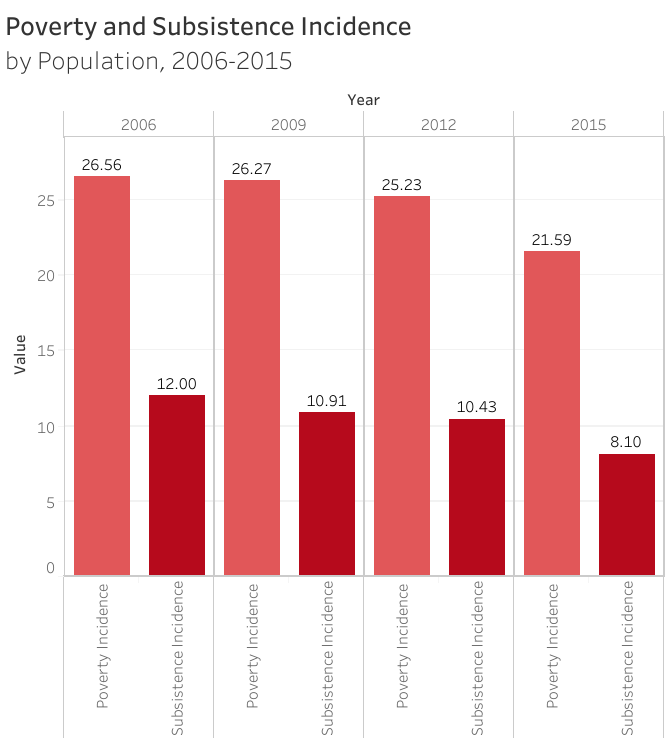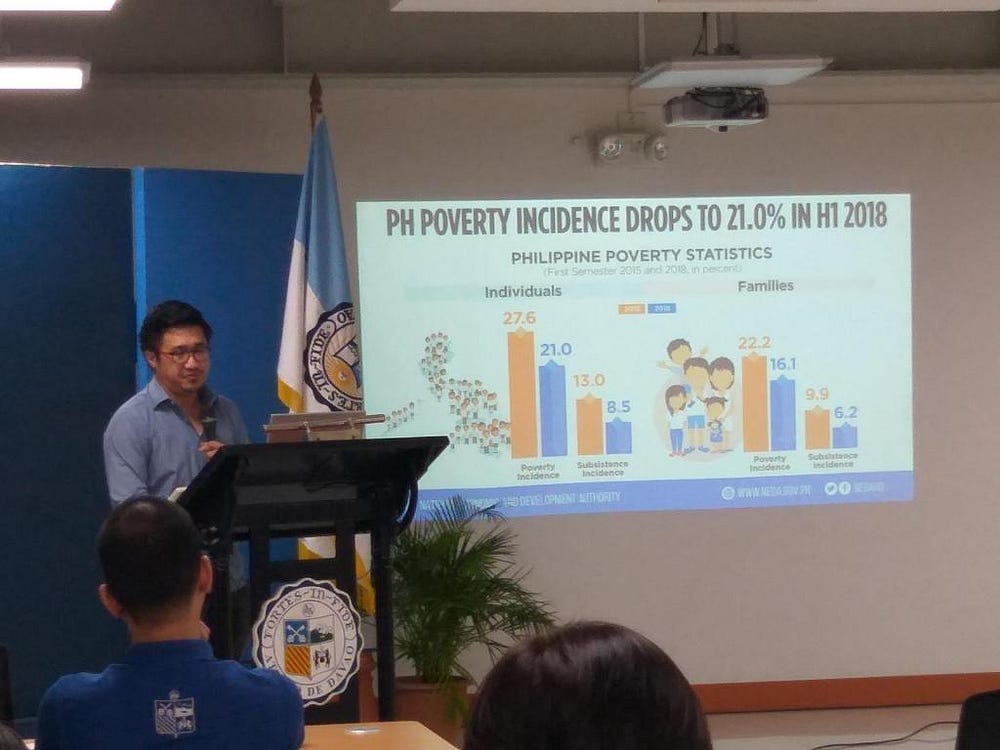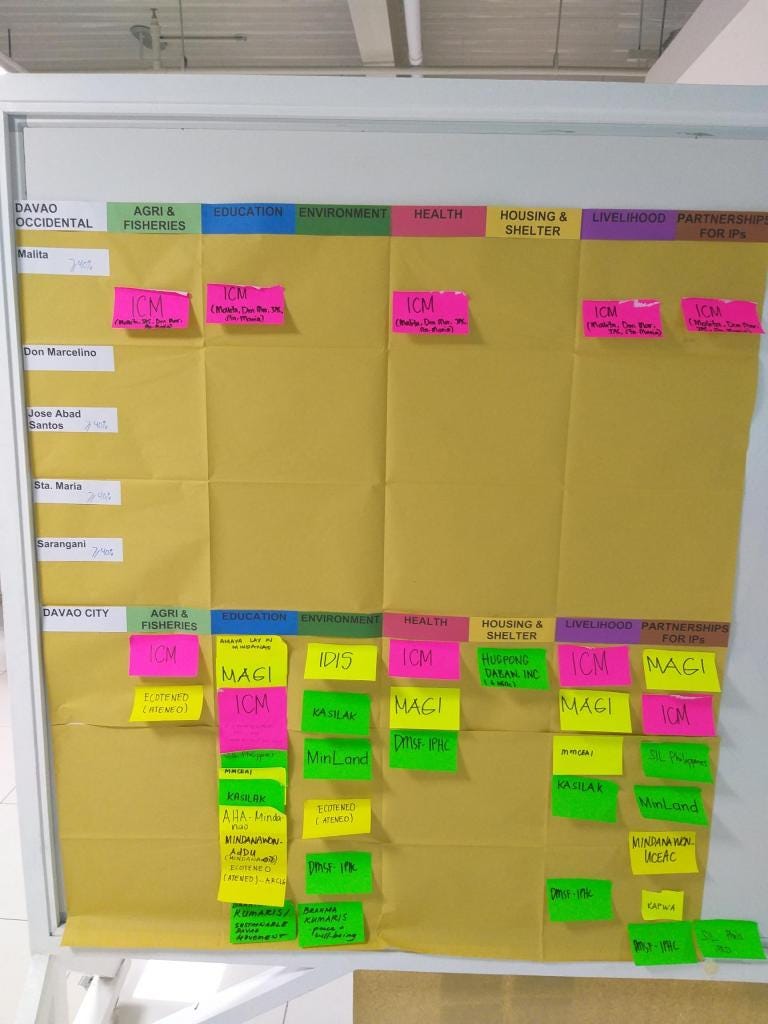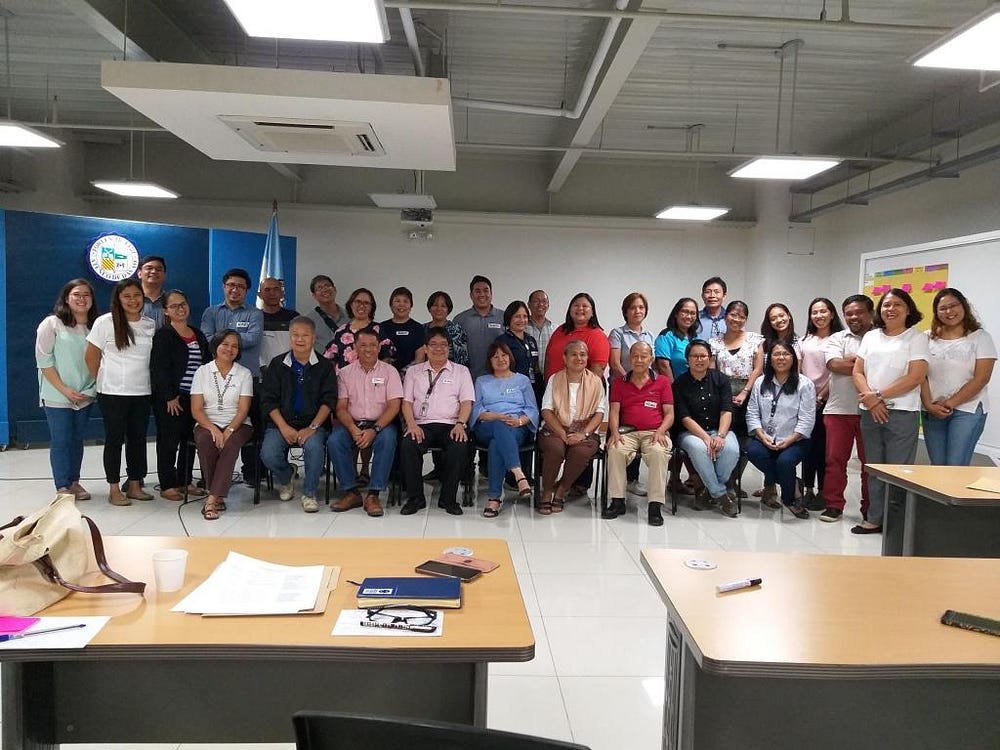A typical pre-COVID19 scene of congestion in the wet markets of urban Manila, on which many vulnerable families depend for their source of nourishment and livelihood. How can physical distancing be reasonable to ask from them? Photo by Jonathan Cuevas.
Reflections on my first month of collaboration with a collective impact movement against poverty
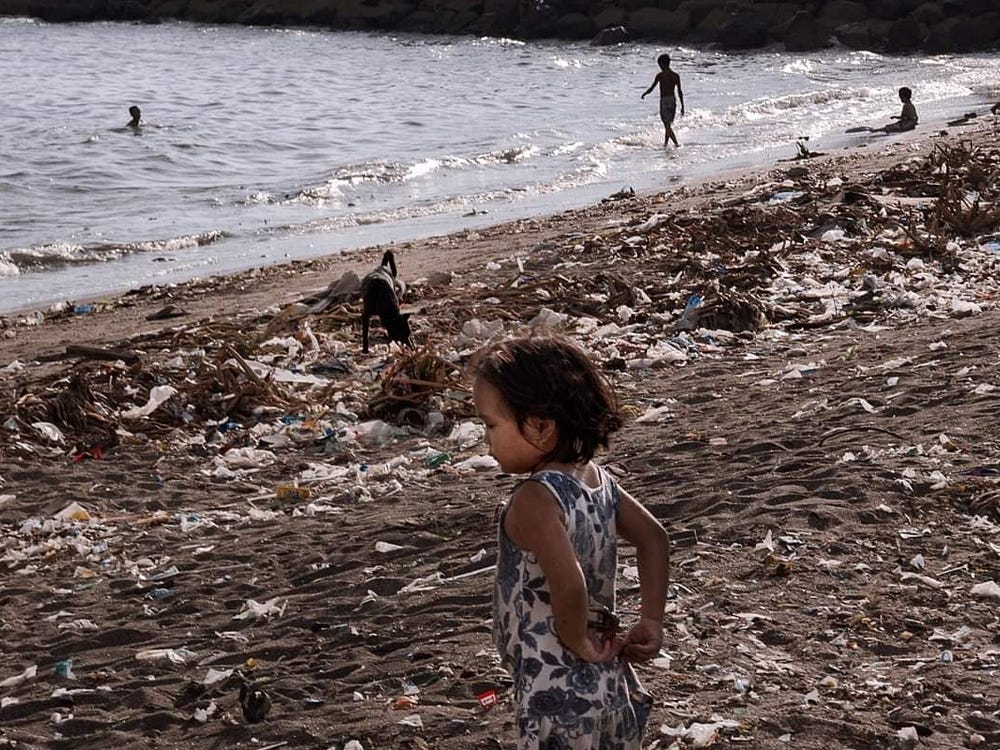
“The Plastic Beach” by Jonathan Hodder
Now that we’ve helped to start a conversation, what knowledge, tools and resources can our Accelerator Lab contribute to the partnership with an unprecedented coalition of civil society organizations to help them achieve their big, audacious goal of lifting 1 million poor families out of extreme poverty by 2030 in the Philippines?
—
When US President John F. Kennedy made a commitment in 1961 to put people on the moon and return them safely to earth before the end of the decade, the technology wasn’t even remotely ready. Yet this first “moonshot” was achieved in eight years’ time. With the urgency of the need to make much faster progress towards achieving the Sustainable Development Goals (SDGs) by 2030, the world needs its own moonshots for development based on audacious innovations.
The moonshot term has a sort-of equivalent in the Filipino language: suntok sa buwan. Literally translated as “punching the moon,” it has a more pessimistic, even sarcastic, overtone. The idiom usually precedes expressions of doubt, advice to take caution, and dire warnings of pain or loss. Suntok sa buwan is oftentimes a declaration of failure.
So, is the goal of eradicating poverty in the Philippines moonshot or suntok sa buwan?
Check out my Tableau Public profile for some vizzes on PSA’s poverty data
(also, for the life of me, I couldn’t successfully embed the viz. halp!)
The government has committed to end extreme poverty by 2030 and is pursuing its ambition to end all poverty by 2040.[1] Are we on track? In the decade before 2015, the poverty incidence among individuals fell to 21.6 percent, from 26.3 percent in 2006-laudable, but slower than the progress of our East Asian neighbors due to high inequality, low agricultural productivity, and natural disasters and conflict.[2] Operating in a world of increasing volatility, uncertainty, complexity, and ambiguity (VUCA) , our progress towards poverty eradication is not happening fast enough.
A business-as-usual approach is not going to get us our poverty moonshot. That’s why I felt extremely excited and anxious at the same time when, as the newly minted Head of Experimentation (minus the white lab coat!) at UNDP Philippines Accelerator Lab (ALab PH), I took on the task of leading our collaboration with Zero Extreme Poverty (ZEP) 2030 Philippines. The coalition was formed when 15 of the biggest civil society networks and organizations in the country committed in 2015 to the goal of lifting more than 1 million families from extreme poverty. As custodian of SDG #1 to eradicate poverty in all its forms, everywhere, UNDP was invited to join ZEP’s lead convenors group. Not only did they agree to focus on the persistent problem of poverty, they also declared that they will do things differently by moving together and ensuring the convergence of their efforts on the ground: a tough task given circumstances.[3]
Collective Impact and Collective Renewal
Guided by an approach to change called collective impact, which requires five conditions to drive social impact on a complex issue (see figure below), ZEP has adopted a common agenda to lift 1 million families from being poorest of the poor to self-sufficiency. More than being a top-down targeting exercise, the goals of ZEP are hinged upon putting the family at the heart of the coalition’s efforts, empowering families to define and pursue their own visions: aspirations to which the development actors on the ground should accord primacy rather than those of their organizations or funders.
ZEP has also adopted a shared measurement framework through five core indicators of poverty[4] and a unified family profiling tool.[5] They aim to achieve convergence on the ground through the implementation of mutually reinforcing activities under the eight thematic clusters: education, health, livelihood, environment, agriculture and fisheries, housing and shelter, partnerships for indigenous peoples, and social justice. Continuous communication is achieved through regular meetings of ZEP and coordination through clusters. A backbone support organization through a secretariat has been established.[6]
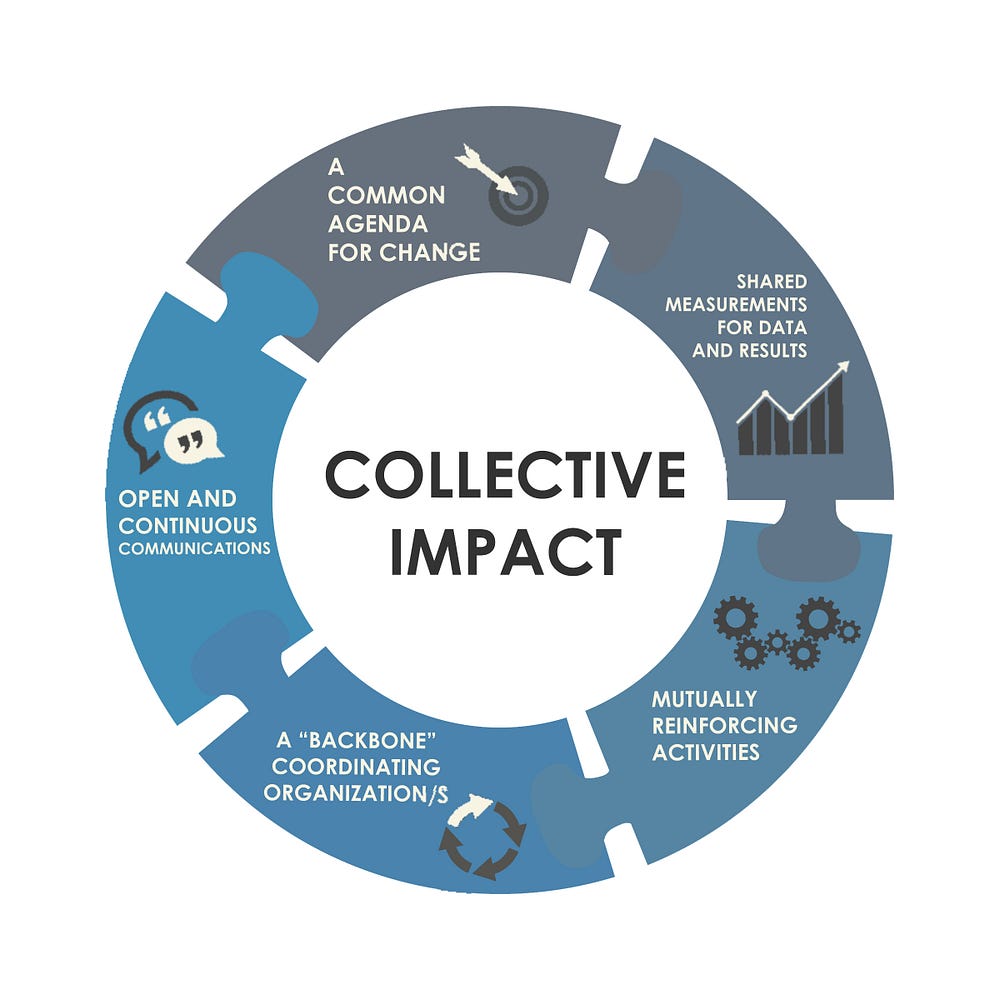
Framework of Collective Impact as rendered by ZEP 2030 PH
Even if ZEP has grown remarkably to nearly one hundred organizations in the last three years-in the process ticking all five boxes of collective impact-the joint leadership has acknowledged that its rate of progress will not be enough to reach its goal. In a retreat jointly organized by UNDP and ZEP, there was a realization that the coalition’s hallmarks-the unified and rigorous profiling of families, a standard process of community engagement, and a single framework for action-have become obstacles for expanding the network and attracting local conveners to join the movement. To foster an environment of mission renewal, the retreat identified the need to develop prototypes for working differently-all of which deal in some way with the challenge of scaling local poverty action through greater local convergence.[7]
If We Go All-In Local, Then…
Fresh from the ZEP retreat, the lead conveners made some crucial decisions to pursue the idea of going “all-in local”. For one, building on earlier successes, they sought to intensify efforts to organize convergence networks in provinces, cities, and municipalities where many or all the clusters of ZEP are active. That’s where the local convergence meeting that I helped facilitate together with Rex (ALab PH’s Head of Solutions Mapping) in Davao last October came into the picture.
To take a broader perspective, the meeting had a regional scope, unlike previous ones which were at best at the provincial or municipal level. ZEP made significant adjustments to the program, reducing the coverage of ZEP’s approaches and profiling tools and instead creating space for explorations into the SDG and poverty situation and conversations on how convergence could be made to work. The other element that made the meeting special was that it was held on the International Day for the Eradication of Poverty (also, at least two earthquakes happened the night before, followed by a handful of aftershocks).
Rex and I brought two hypotheses with us to the gathering of local ZEP partners and other stakeholders: (i) if we present evidence and data in a convincing way, then stakeholders will be moved to act-in this case, for the local organizations to join ZEP; and (ii) if we draw on innovative approaches, such as empathy and issues mapping, then conversations on collaboration would be more productive, leading to clearer action on the ground.
Here I am making a presentation on the poverty incidence using a borrowed infographic from the National Economic and Development Authority.
During the meeting, the need for actionable data-more regular, timely, and granular data-on the poverty situation in Davao was emphasized. Official poverty statistics, which I used as the starting point for the conversation, come in three-year intervals and with at best a year-long delay; and the municipal-level poverty estimates available were four years old. We asked if there are other means to get this data that are sufficiently robust, even if not official, to guide poverty action? Perhaps, informally collected data by local governments and by the CSOs can be leveraged. We were fortunate that Ateneo de Davao University, who hosted the meeting, gave an impromptu presentation of its city-wide survey on self-rated poverty: a demonstration of what could be tried on a larger regional scale.
How can we make data more actionable by relating to other important sources of information? With the ZEP secretariat, we ran an exercise on large Manila paper sheets where matrices containing the names of all the locales of Davao region and the eight thematic clusters of ZEP were plastered around the hall. Participants were then asked to place sticky notes where their organizations and their respective projects or initiatives were present. We then ran an “analog” cluster analysis: we reviewed where the organizations were bunching up, in which municipalities, and under which themes. We then tagged which cities and municipalities had a poverty incidence of more than 30 percent-there were 22 in all.
It turned out that the organizations in the room were only in nine of those poorest municipalities!
Only one CSO is working in Davao Occidental — the poorest province in Davao, with three municipalities with skyrocketing poverty rates — while a lot are based in Davao City, the economic powerhouse in Mindanao.
There are two main caveats to this revelation. First, the data that we have are four years old and a lot of things may have already changed since then. Second, there are a lot of other organizations who were not represented in the room at that time. Still, the gap was glaring, and the group recognized that things need to change. How could ZEP organizations be present and serve these areas better? Perhaps they can find other CSOs already present in those municipalities and encourage them to join the ZEP fold, or reach out to local officials and other sectors in these municipalities to raise awareness about poverty and advocate for eradicating extreme poverty? The flywheel of all-in local is under way!
Learning Step by Step
Rex and I then ran lab sessions to facilitate discussion about the type of local convergence ZEP envisioned. We used a participatory methodology called “common ground” to better understand the players who are key to making local convergence work: national CSOs and non-government organizations (NGOs), local NGOs and peoples’ organizations (POs), corporate foundations, and local government offices. We asked the participants to draw up empathy maps on each of these actors to identify the goals, contexts, pain points, and motivations as to why they would collaborate with ZEP. The directive was to put themselves in the shoes of a persona-the mayor of a municipality, a community leader, etc.
It’s not easy to leave our biases behind, for instance, when I passed by the group who was doing the map for local government, I think I guffawed too loudly when the first comment posted in the “motivation” box was “money and power”! But as the boards were populated with more sticky notes, a more balanced understanding of the pain points and motives of these stakeholders emerged. NGOs who are frequently romanticized for their development zeal had their own pitfalls such as being too limited by their organizations’ specific mission. Those whose intentions were often doubted, like corporate foundations, bring in an indispensable value to the movement through their focus on impact. These were the things that made the body realized that they are not enemies and convergence of motivations and actions is possible-even if they don’t necessarily agree on everything!
The local government group intensely trying to work on some empathy for their persona!
These are early days for our accelerator lab, so I am learning too. As the meeting was already running over time, we decided to cut the issue mapping session. In future I would structure the session better, giving participants more time to grasp the tools and use them to discuss issues and generate ideas. Related to that, it’s important to give participants enough time to grasp new, and often alien, concepts. I need to learn to avoid jargon like the plague!
Our ZEP colleagues who were at the meeting were itching for change, especially for those in the poorest pockets of Davao, so much that when we were about to end the meeting and called the lead convener to say some concluding words, not a few hands were raised to ask, “we’re done?” An impromptu discussion happened on how to organize and mobilize for the next steps in the journey. They agreed on the need to meet again to develop a more detailed plan of action. I can’t wait to see what they have come up with.
So now, tell me what you think: is zero extreme poverty in Davao and in the rest of the country moonshot or suntok sa buwan?
After a long day and some aftershocks!
All other photos from Rex Lor. Special thanks are due to ZEP’s Frammie Martin (PBSP), Gina Estipona (AF), and Leah Lagahit (ICM) for bearing with me and Rex in Davao.
[1] Under the current iteration of the Philippine Development Plan, the government aims to reduce poverty incidence among the population to 14 percent by 2022. That translates to about 1 million Filipinos lifted from poverty annually over six years.
[2] In this report, the World Bank provides a succinct yet comprehensive diagnosis on the Philippines’ progress in reducing poverty.
[3] To the uninitiated, while Philippine civil society is regarded to be among the most vibrant in the world ( at least according to ADB), it is also quite fragmented in various dimensions-including geographically, sectorally, and even politically.
[4] If a family of six’s income falls below PHP 350 per day; If the family missed two suppers in the past week; if children 5–18 years old did not attend school due to poverty; and if the family does not have access to potable water nor a sanitary toilet. The relaxation of the data collection approach of course creates new challenges, which I hope to write about in a month)
[5] Poverty Probability Index (PPI)
[6] Currently housed under the Philippine Business for Social Progress (PBSP).
[7] To make it easier for local conveners to join ZEP and lead convergence efforts on the ground. To connect organizations and solutions with each other without centralized convening. To allow for variations in organizing approaches and in data collection tools while still giving the network a good grasp of its progress. To create space for exploring the network to explore and renew its approaches.
Originally published at http://kapicapistrano.wordpress.com on November 13, 2019.

 Locations
Locations
